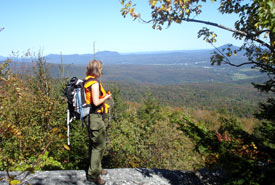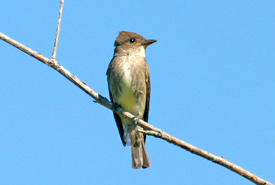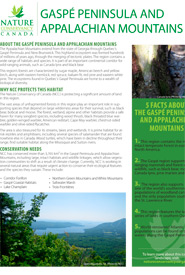Gaspé Peninsula and Appalachian Mountains 101

Mount Burnt property, Northern Green Mountains, QC (Photo by Appalachian Corridor)
The Appalachian Mountains extend from the state of Georgia through Quebec’s Gaspé Peninsula and New Brunswick. This highland ecosystem was formed hundreds of millions of years ago, through the merging of tectonic plates. The region contains a wide range of habitats and species. It is part of an important continental corridor for wild-ranging animals, such as Canada lynx and black bear.
The ecosystems found in Quebec’s Gaspé Peninsula are home to a wealth of biological diversity.
Why NCC protects this habitat
The Nature Conservancy of Canada (NCC) is protecting a significant amount of land in this region.

Olive-sided flycatcher (Photo by R. Hocken)
The vast areas of unfragmented forests in this region play an important role in supporting species that depend on large wilderness areas for their survival, such as black bear, bobcat and moose. The forest, wetland, alpine and other habitats provide a safe haven for many songbird species, including wood thrush, black-throated blue warbler, golden-winged warbler, American redstart, Cape May warbler, chestnut-sided warbler and olive-sided flycatcher.
The area is also treasured for its streams, lakes and wetlands. It is prime habitat for at-risk reptiles and amphibians, including several species of salamander that are found nowhere else in Canada. Wood turtles, which have been in decline throughout their range, find suitable habitat along the Missisquoi and Sutton rivers.
Conservation needs
NCC has conserved more than 3,765 km² in the Gaspé Peninsula and Appalachian Mountains, including large, intact habitats and wildlife linkages, which allow vegetation communities to shift as a result of climate change. Currently, NCC is working in several natural areas that require urgent action to conserve their ecological features and the species they sustain. These include:
- Corridor Forillon
- Gaspé Coastal Habitats
- Lake Champlain
- Northern Green Mountains
- Saltwater Marsh
- White Mountains
Five facts about the Gaspé Peninsula and Appalachian Mountains
- This region contains the most intact temperate forest in eastern North America.
- The Gaspé region supports wide‐ranging mammals and forest-dwelling wildlife, such as black bear, moose, Canada lynx, pine marten and bobcat.
- This region also supports one of the world’s southernmost populations of woodland caribou and the only population south of the St. Lawrence River.
- This region features the last intact series of lakes in southern Quebec.
- World-renowned Atlantic salmon populations can be found in the waters along the Gaspé Peninsula.
This region is one of the last wilderness areas in southern Quebec and New Brunswick. It is also one of the most intact temperate forests in eastern North America and is an important continental corridor for wide-ranging mammals, including Canada lynx, black bear and pine marten. NCC is working closely with partners in the U.S. to ensure that this mountain corridor is protected.




